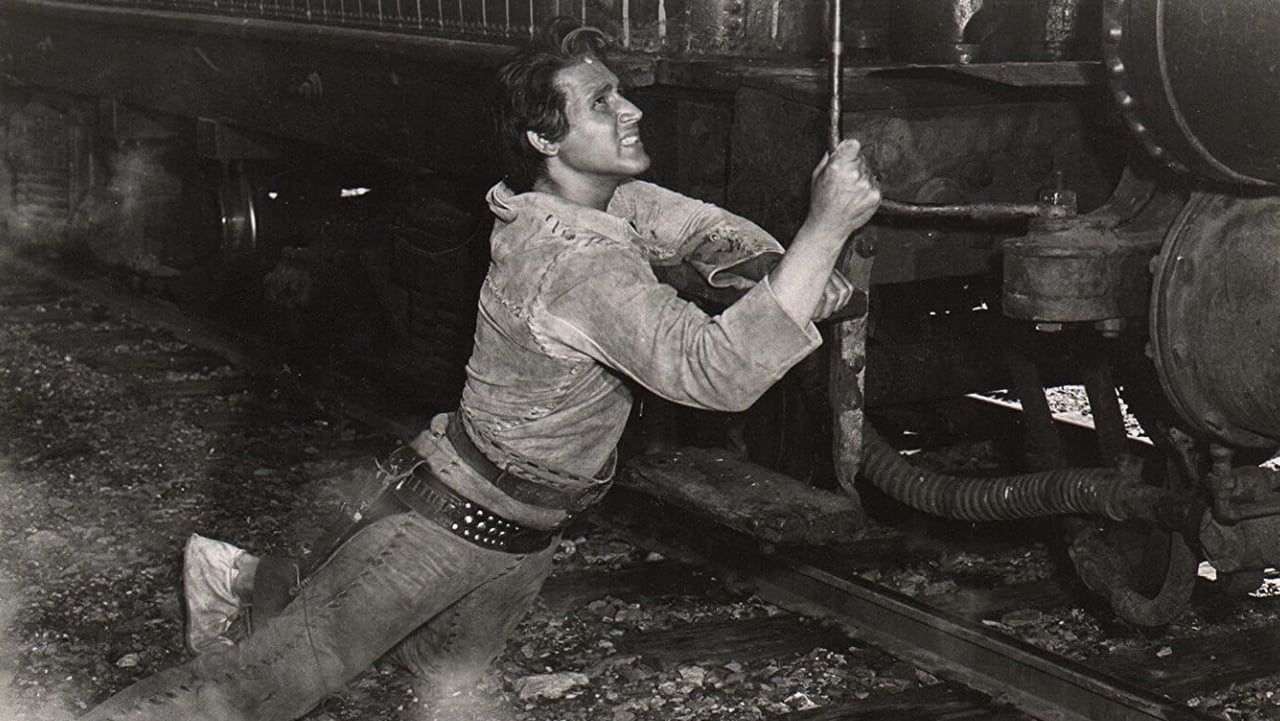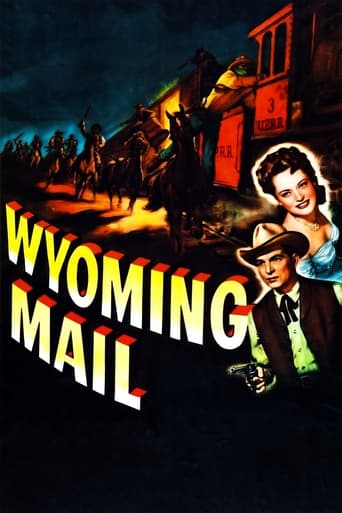

Wonderful character development!
... View MoreGood concept, poorly executed.
... View MoreA lot of perfectly good film show their cards early, establish a unique premise and let the audience explore a topic at a leisurely pace, without much in terms of surprise. this film is not one of those films.
... View MoreThe plot isn't so bad, but the pace of storytelling is too slow which makes people bored. Certain moments are so obvious and unnecessary for the main plot. I would've fast-forwarded those moments if it was an online streaming. The ending looks like implying a sequel, not sure if this movie will get one
... View MoreStephen McNally (Steve Davis), Alexis Smith (Mary Williams), Howard da Silva (Cavanaugh), Ed Begley (Warden Haynes), Dan Riss (George Armstrong), Roy Roberts (Charles DeHaven), Whit Bissell (Sam Wallace), Armando Silvestre (Indian Joe), James Arness (Russell), Richard Jaeckel (Nate), Frankie Darro (Rufe), Felipe Turich (Pete), Gene Evans (Shep), Richard Egan (Beale), Frank Fenton (Gilson), Emerson Treacy (Ben), Harry Tyler (Pap), Charles Evans (senate committee chairman), Ed Cassidy (sheriff), Jay Barney Zed), Eric Alden, Ralph Brooks (mail clerks), John L. Cason (Red Monte), Wheaton Chambers, Howard M. Mitchell (conductors), Chick Chandler (waiter), John Cliff, John Indrisano, Herbert Naish (guards), Ed East (blacksmith), Roy Engel (ticket seller), Captain Garcia, Jennings Miles (prisoners), Harold Goodwin, Guy Wilkerson (cowboys), Charles McAvoy (spectator), Forrest Matthews (Edmund), Grandon Rhodes (Senator Dowell), Frank Richards (prison contact), Harry Wilson (losing bettor), Frankie Van (referee), Tony Roux (Mexican proprietor), and Forbes Murray, Edward Rickard, Sayre Dearing, Fred Aldrich.Narrated by Gerald Mohr.Director: REGINALD LeBORG. Screenplay: Harry Essex, Leonard Lee. Story: Robert Hardy Andrews. Photography in Color by Technicolor by Russell Metty. Film editor: Edward Curtiss. Music director: Joseph Gershenson. Art directors: Bernard Herzbrun, Hilyard Brown. Set decorators: Russell A. Gausman and John Austin. Costumes designed by Bill Thomas. Make- up: Bud Westmore, assisted by Gene Hibbs. Hair styles: Joan St Oegger, assisted by Helen Turpin. Technicolor color consultant: William Fritzsche. Songs: "Endlessly" (Smith) by Kim Gannon and Walter Kent; "Take Me To Town" (chorus) by Dan Shapiro and Lester Lee. Choreographer: Harold Belfer. Camera operator: Philip H. Lathrop. Still photographs: Max Nippell. Grip: Dean Paup. Continuity girl: Dorothy Hughes. Assistant director: Ronnie Rondell. Production manager: Jack Gertsman. Sound recording: Leslie I. Carey and Frank Moran. Western Electric Sound Recording. Producer: Aubrey Schenck.Copyright 4 October 1950 by Universal Pictures Co., Inc. A Universal-International Picture. New York opening at Loew's Criterion: 21 October 1950. U.K. release: 20 November 1950. Australian release: 28 December 1950. 87 minutes. SYNOPSIS: Post office trains are threatened by well-organized outlaws.NOTES: Switching from Warner Brothers, this film marked Alexis Smith's first venture under her Universal contract.COMMENT: A top western in all departments. Most entertaining, richly produced, excitingly staged, reasonably suspenseful, handsomely photographed and gorgeously costumed, it also boasts a fascinating cast of interesting players. Even Reginald LeBorg's direction ranks way above his usual level of so-so competence. Naturally, train buffs will be in seventh heaven, but I also enjoyed all the telegraph lore, the awesome natural scenery, the lavish period props and interiors, the well-honed music score, not to mention the peppery dialogue and novel bits of business, plus the action, fights, hard riding and stunts.
... View MoreWYOMING MAIL 1950This Universal International production is set in 1869 just after the U.S. Postal Service started moving the mail by railway. These "post office on wheels," are being constantly robbed on a section or rail running through Wyoming Territory. The Postmaster hires former Secret Service operative, Stephen McNally to work undercover. McNally is sent out to Wyoming to look into the robberies. The government figures it is the work of a well-organized gang with inside info. McNally is to contact another undercover man in Cheyenne. The undercover man is killed before McNally can reach Cheyenne. McNally manages to trail some marked money to a man, Ed Begley. Begley happens to be the warden of the Territorial Prison. While digging around for info, McNally has time to romance attractive dance hall singer, Alexis Smith. With the help of a U.S. Marshall, McNally pretends to be a wanted bank hold-up man. With the aid of the Marshall there is soon a posse after McNally. McNally is grabbed up and hauled off to the prison. His new contact is Armando Silvestre, who is playing a bounty hunter of Native Indian decent. Silvestre arranges to make periodic visits to check on McNally. Besides watching the warden, McNally is trying to meet up with inmate Whit Bissell. Bissell is a former bank robber whose money they believe was taken by the crooked warden, Begley. Having collected the info he needs, McNally pulls a prison break with the aid of Silvestre. They take Bissell along to testify against Begley. Bissell however is fatally wounded during the getaway. Bissell does however put McNally onto who and where the train robbers are.It does not take long and McNally is soon part of this gang, which includes, Gene Evans, James Arness, Felipe Turich and Richard Jaeckel. Much to McNally's surprise, it turns out that Alexis Smith is also part of the gang. To top that off, railway guard Howard Da Silva is also in the criminal mix. The gang are up for another job and head off to hit the train. McNally manages to get a message to Silvestre to warn the railway of the job. The warning though is intercepted and Silvestre shot. The gang now knows that McNally is really with the law and he barely escapes by jumping off a cliff into a raging river. The robbery goes sideways with most of the gang being killed. The viewer now learns that the real inside man was railway district superintendent, Roy Roberts. Roberts has been feeding the gang inside info on big cash deliveries by the post office. Miss Smith by this time has decided that the criminal life is not to her liking. She is grabbed up and taken to the gang's cliff side hideout. There are a few quick horse chases, gun battles etc needed before the last of the nasty types is disposed of, and Miss Smith rescued. Of course McNally and Smith get married and ride off (by train) into the sunset. This is a pretty entertaining B-western that moves along at a pretty good pace. There is the odd plot problem, but the pace covers these up nicely. The nice Technicolor is an added bonus for the watcher.The director was long time B helmsman, Reginald LeBorg. LeBorg is best known for a string of Universal Studio horror films like, THE MUMMY'S GHOST, JUNGLE WOMAN, CALLING DR. DEATH and DEAD MAN'S EYES.The cinematographer on this great looking duster was two-time Oscar nominated, one time winner, Russell Metty. Metty won his Oscar for his work on, SPARTACUS. Look close and you will see future Hollywood leading man, Richard Egan in a small bit. Well worth a look if you are fan of the genre.
... View MorePretty good Western that gets better as it goes along. Railroad agent Steve Davis (McNally) goes undercover to catch an elaborate gang of train robbers. Along the way, he meets lovely songstress Mary Williams (Smith), but much worse, has to go to prison to establish his outlaw cover. The gang, it turns out, has respectable confederates but we can't be sure who they are.There're several good surprises, plus some nice touches from director LeBorg— e. g. a wounded Indian Joe trying to hook on the train, the final scene that hits the right notes, a frantic outlaw (Jaeckle) atop an exploding baggage car. Also, that rock formation of the gang's hideout is impressive as heck, with its spindly ladders to the caves at the top. Then there's a splash or two of great blue sky scenery.The supporting cast is also notable—Begley, DaSilva, Evans and Jaeckle, plus a young, curly-haired James Arness and-- look quickly—Richard Egan as a prison guard. Universal Studio did a number of these Technicolor Westerns at the time, using solid performers and location filming. None that I've seen reach the first rank, but do remain solid entertainment for horse opera fans, including this one.
... View MoreThe satisfactions of the Technicolor western register in this production line co feature, with Russell Metty's camerawork and the studio's wooden cowboy town, train station and saloon interiors always a pleasurable environment. The cast is good too so there's only the routine direction to take issue with and Le Borg has exerted himself a few times here - Smith's anguished walk back to the railworker club, knowing her lover is a government spy, is one.Better work followed but this is enjoyable.
... View More